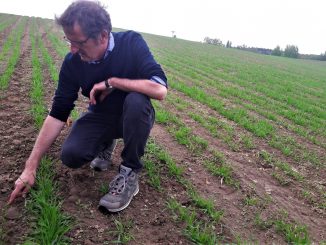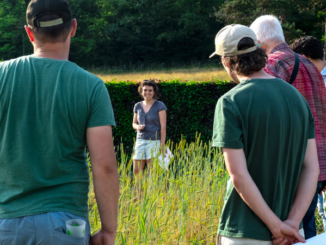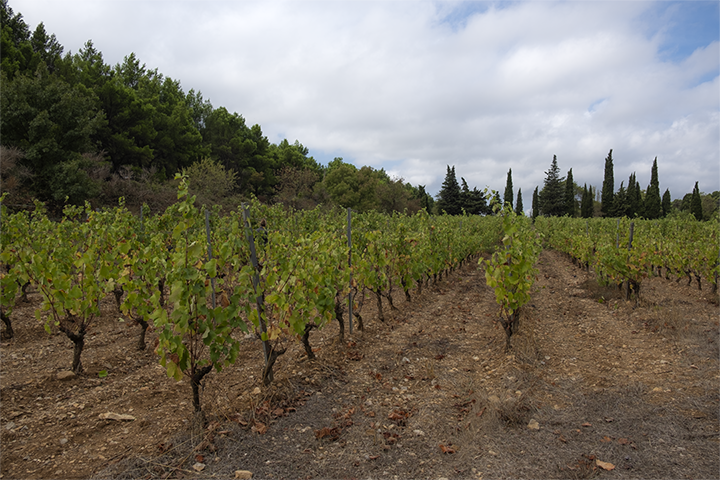
How is a new generation of French winegrowers responding to the extreme temperatures and droughts becoming more pronounced in recent years? This summer, Adèle Pautrat visited Sainte Marie des Crozes, an organic and biodynamic Domaine in the village of Douzens in southern France. Winery Manager Christelle Alias and her team cultivate 15 different grape varieties to produce an impressive range of wines, all the while aiming to adapt and transform their viticulture in light of the challenges climate change poses. Local grape varieties will play an important role in making the vineyards resilient.
Adèle Pautrat documents – in words and photos – her time spent at Sainte Marie des Crozes in August and September 2022. She describes the problems that extreme temperatures and drought cause for the vine and how, in response to this, more professionals are seeing organic viticulture as a necessity. There is cause for hope in the vineyards of southern France.
Winds of change in Corbières vineyards
I met Christelle Alias during a winegrowing tour on a foggy August morning in the Aude valley of southern France. As we walked, the morning haze gave way to a few clouds, something we were no longer used to seeing here, where summer 2022 was marked by the insistent presence of an indecent sun.
Christelle is the manager of the Sainte-Marie des Crozes winery in Douzens, a small village of a few hundred inhabitants about 20 kilometres east of Carcassonne and below the northern slope of the Alaric mountain in the Corbières. The Domaine’s cellar is surprisingly located in the heart of the village, opposite the elementary school. Its forty hectares of vines are spread over three different terroirs, less surprising in this rugged region with heterogeneous soil and climate characteristics.
Sainte Marie des Crozes has been a family business for five generations. Christelle joined it in 2013, after travelling to New Zealand and Australia where she gained exotic viticultural knowledge. Back home, she decided to dust off her know-how, filled with the joyful spirit of creativity and transgression characteristic of the new generation of Corbières winegrowers who are still too harshly judged by many staid “specialists”.
While faithful to the reference grape varieties of the Corbières AOC, Grenache and Carignan, Christelle is also interested in trying varieties from elsewhere, such as Pinots Noirs or Roussanne. She works with a team of 5 people cultivating 15 different grape varieties and producing an astonishing range of wines that combine tradition with innovation, proven know-how with modernity, rigour with freedom. Above all, she questions her practices in light of climate change, concerned with preserving the land and ensuring the persistence of knowledge. The Domaine obtained the organic label in 2014 and the Demeter biodynamic one in 2020. New ambitions that echo the worsening climatic pressures that the region is experiencing.
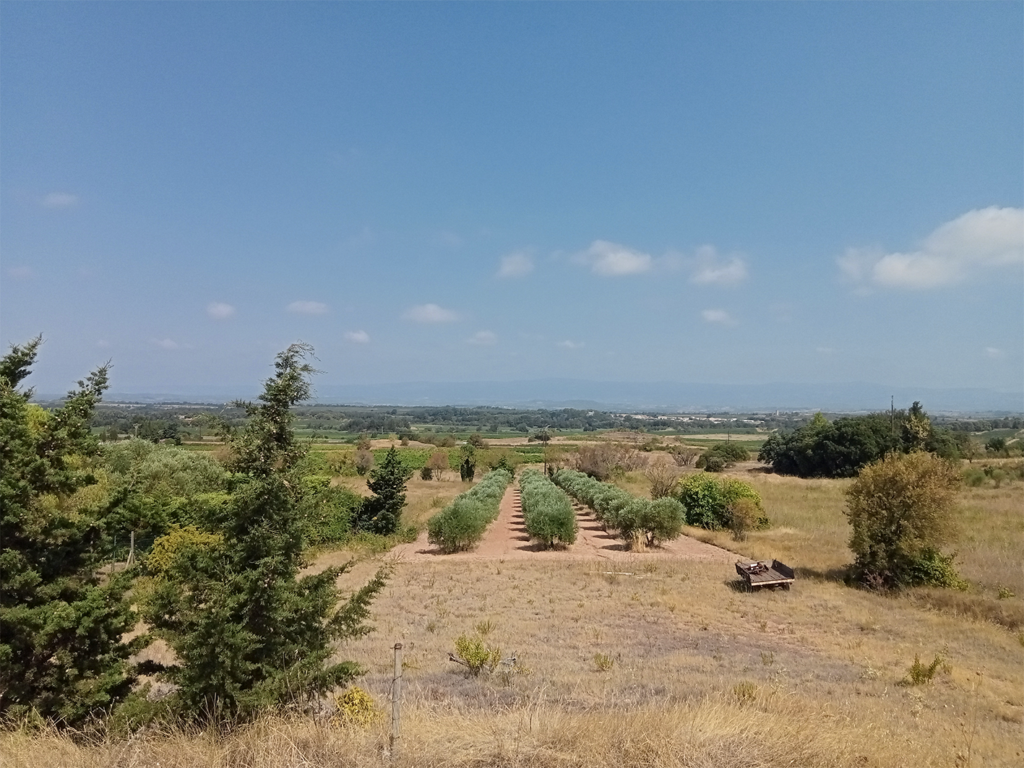
Chronic droughts and water shortages
The area, a sort of outpost of the Mediterranean climate, is used to water deficits. The climate is dry and hot, with very little rainfall in summer. However, in recent years, this phenomenon has become more pronounced due to low autumn and winter rainfall no longer ensuring the recharging of groundwater.
In 2022, the whole of metropolitan France started the spring with a water deficit. At the time of my first visit to the Domaine Sainte Marie des Crozes, it had rained only once in over four months. Combined with extreme temperatures, this situation led to an intense drought with local rivers drying up and water reserves disappearing. A friend of mine who does canyoning in the region observed that the St Ferréol lake in the Black Mountain had “transformed into a puddle”.
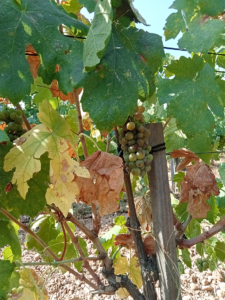
The vine doesn’t need to be watered. It draws the water it needs from underground water reserves. When the level of these reserves is too low, difficulties ensue. It is possible to irrigate the vineyard, especially in the Aude valley where its tributaries such as the Orbieu flow, but Christelle is sceptical. She fears that this would affect the vine’s ability to self-supply, making it less resilient and more fragile to climatic hazards.
If the vine lacks water, the main risk is that it will go on standby, waiting to find traces of moisture to continue to develop. This can delay the date of harvest and, in very hot weather, have dramatic consequences. A grape too intensely exposed to the sun’s rays ends up burning. The plant’s foliage dries out and falls off, limiting photosynthesis and thus the production of glucose and the ripening of the fruit.
This year in the Aude, the harvest actually began in mid-August, which is unusually early. In fact, many of the grapes Christelle let me taste were already very sweet, and one could see here and there a few bunches of crimson fruit. Christelle seems philosophical about the situation. Professionals in the sector are indeed getting used to the extreme temperature variations and the unusual weather episodes that are now occurring all year long.
Mitigating impacts, adapting, transforming
The awareness of the French wine sector to the rapid changes in the climate is widely palpable. A growing number of professionals are convinced that the transition to organic viticulture is necessary to reduce their participation in a phenomenon in which they are among the first victims.
Occitania, with 263,000 hectares of vineyards spread over two production basins, is France’s largest wine region in terms of surface area. It is also the leading organic wine region in France with 33,563 hectares certified organic and 23,480 hectares in conversion in 2021.
Christelle agrees at the beginning of the walk – “organic is simple: it means no chemicals. Biodynamics on the other hand, is more complicated to characterise”.
And for good reason; if organic intends mainly to attenuate global warming by reducing the emissions of greenhouse gases related to the production, transport and spreading of farm chemicals, biodynamic aims more largely at adapting and transforming viticultural practices in response to the changes already here.
The private biodynamic certification organisation Demeter defines “biodynamic” as follows: “a holistic agriculture that considers the farm and more generally Nature as a living ecosystem where animal, plant and human act in synergy.” As a result, “biodynamic Domaines [would be] more autonomous, [respecting] the cycles that give rhythm to the life of the Earth.”
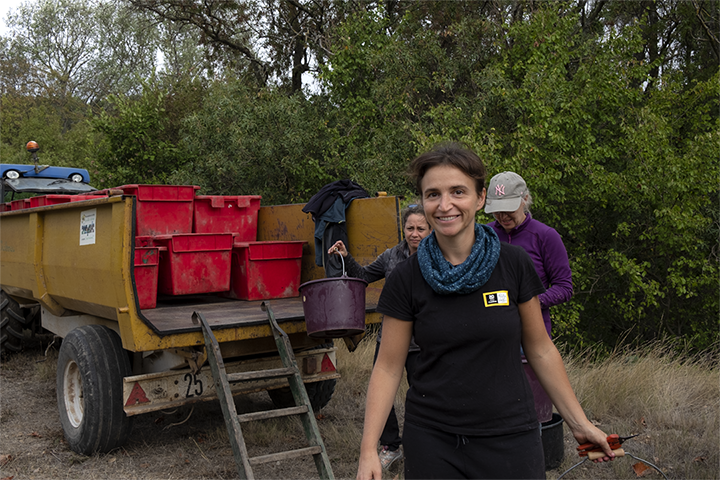
Biodynamics: adaptation and resilience
One of the main objectives of biodynamics is to be regenerative. In viticulture this translates into concrete interventions, some of which are implemented at Domaine Sainte-Marie des Crozes.
First, nourish the soil with natural fertilisers. The Domaine’s recipe: 100g of cow dung per hectare diluted in water, sprayed twice a year, in November and early spring.
Another natural preparation is silica, a ground and diluted quartz flour (4g per hectare), which rectifies the vine’s foliage and promotes photosynthesis. Photosynthesis, necessary for the good development of the plant, also fixes carbon dioxide in the soil and allows its transformation into organic matter.
Between rows of vines Christelle’s team sows a mixture of sweet peas, mustard, oats and fava beans, which have the capacity to absorb nitrogen and/or trap nitrate, further reducing the amount of greenhouse gases in the atmosphere. These cooperative plants are cut in April and either left on the ground to keep it cool, or buried in the soil to act as green manure.
Grape varieties for the land of heat and wind
The choice of the cultivated grape varieties is also important because not all of them react in the same way to rising temperatures. Carignan, nicknamed the “camel of the Corbières”, is undoubtedly the best adapted to this land of heat and wind. It is mostly planted on soils with low water reserves and on the hottest slopes. Grenache, capable of closing its pores and storing water, is a grape variety that transpires little and also resists drought rather well. On the contrary, Syrah, originally from the Côtes du Rhône, is much less resistant to drought. Yet this variety is widespread in the south, massively introduced when the vineyards of the region stopped supplying the Châteaux of Bordeaux with grapes and aspired to produce better quality wines. It has even dethroned Carignan, which for some time was mistakenly thought to be responsible for the poor quality of Languedoc wines.
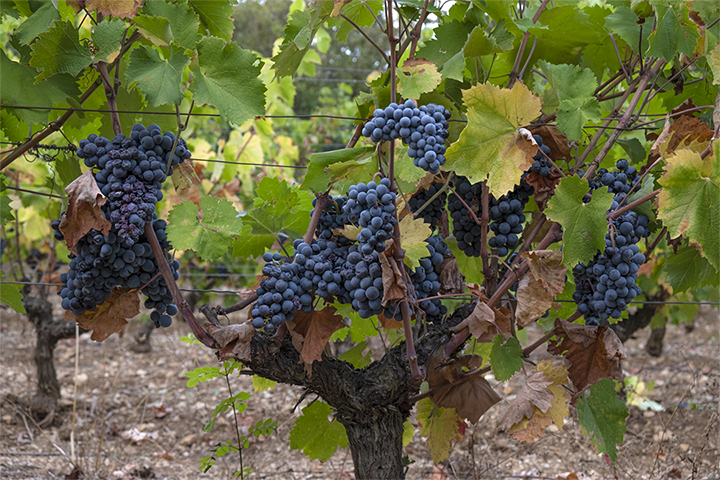
The Domaine Sainte-Marie des Crozes bears the traces of this recent viticultural heritage: of the 40 hectares cultivated, 10 are devoted to Grenache and 10 others to Syrah. The range of wines offered by the Domaine is therefore very dependent on this second variety, and for Christelle there is no question of pulling out the vines. But when I ask her about her priorities in the face of new challenges posed by climate change, she begins by confirming that she now wants to focus on indigenous grape varieties. Other important elements for her are: 1) investing more in the implementation of practices that regenerate the soil and 2) taking the water parameter seriously into account, particularly by participating in the awareness and organising efforts of farmers and winegrowers at the local level to ensure a rational sharing of this resource.
Christelle recognises that in biodynamic farming it is difficult to be 100% accomplished. In this business nothing is obvious. If you set the bar too high, too fast, you get frustrated. That’s why it’s important to prioritise, to test, learn and, above all, to keep a lot of humility.
What about seeing the glass half full?
I came back to the Domaine at the end of September to photograph the last day of harvest. I was surprised to be told that the season’s yield turned out to be far from disastrous. On the contrary, the maturation was very good and the first tests in the vats give wines already with a lot of character. Overall, the vineyard experienced few drought-related losses.
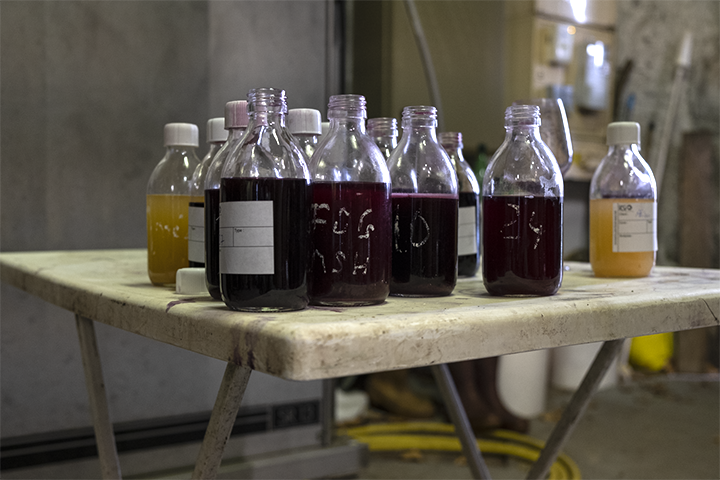
In talking with a member of the team, I discovered that not everyone is worried about the future of the vineyards of southern France. Not all terroirs suffer from the heat, even in the Corbières, and there is a real belief in the adaptability of local grape varieties, as demonstrated by the Carignan which was “particularly amazing” this summer. Above all, many vineyards, like the Domaine Sainte Marie des Crozes, are actually able to return to more traditional and sustainable practices – such as pruning the trunks to keep them low and facilitate leaf irrigation, or picking part of the harvest by hand to protect the soil. It is the 100% mechanised Domaines that are most likely to be hit hard because of their lack of adaptability and resilience.
If we then choose to focus on the positive, let’s raise a glass to the increasing number of operators who will likely be encouraged to follow the paths of the organic and biodynamic vanguards, for the wellbeing of our land, our soil and our taste buds.
Photo Essay | Hand Harvesting in a Biodynamic Vineyard
Words and photographs by Adèle Pautrat
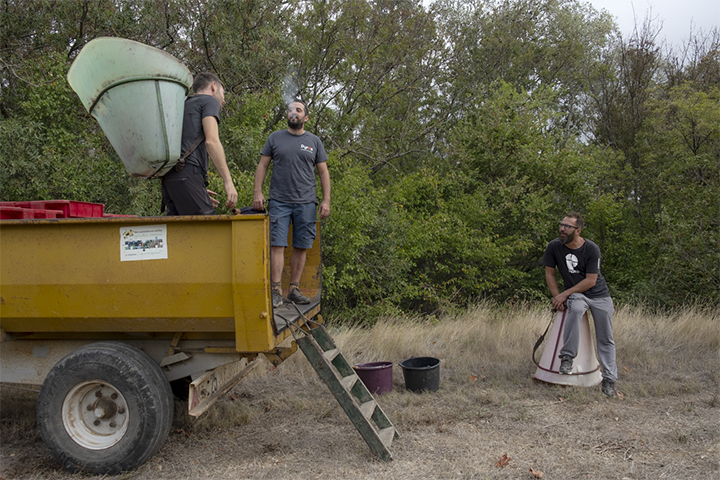
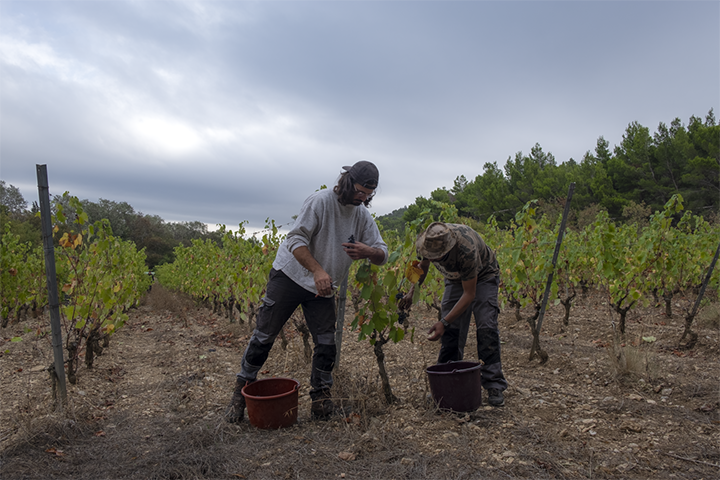
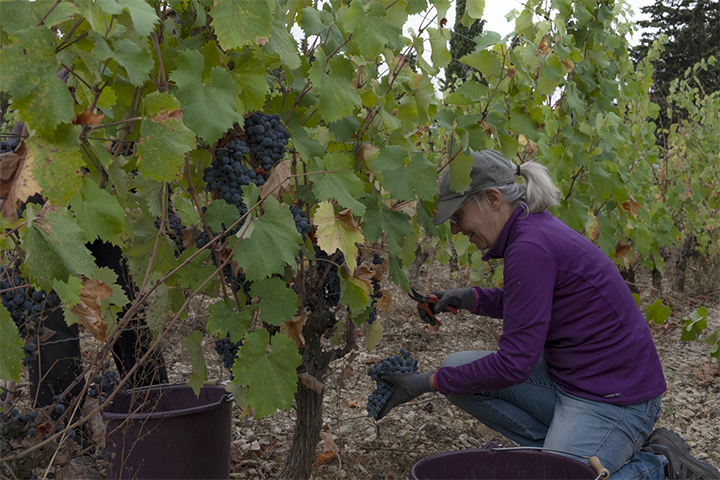
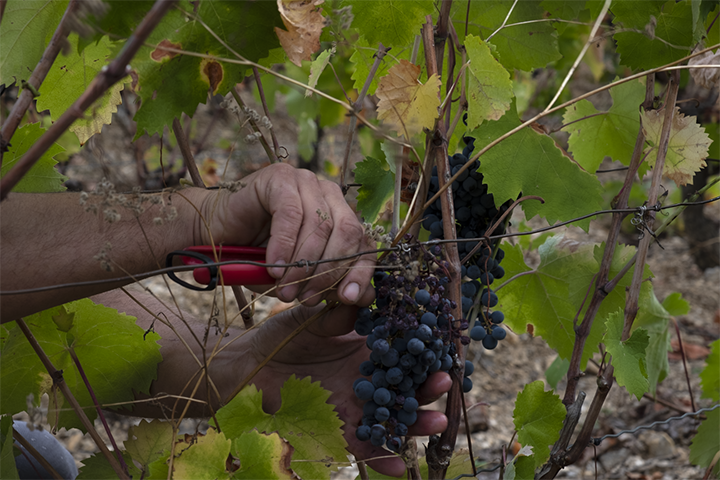
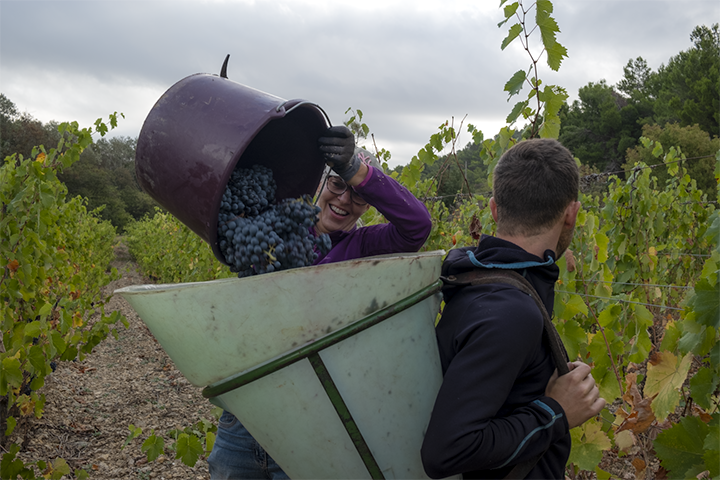
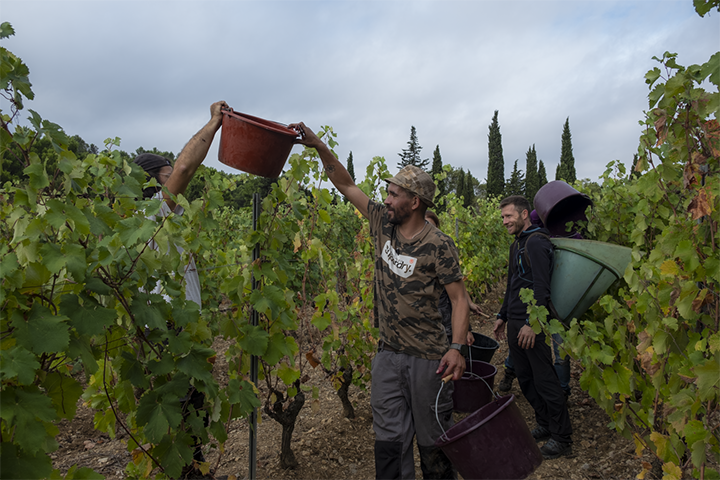
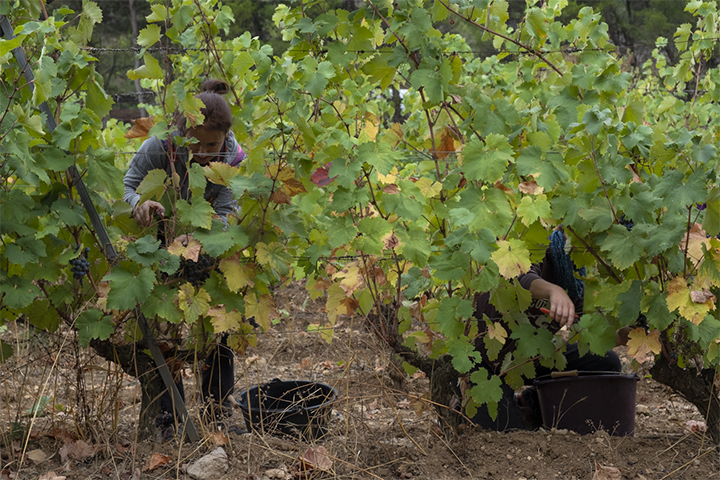
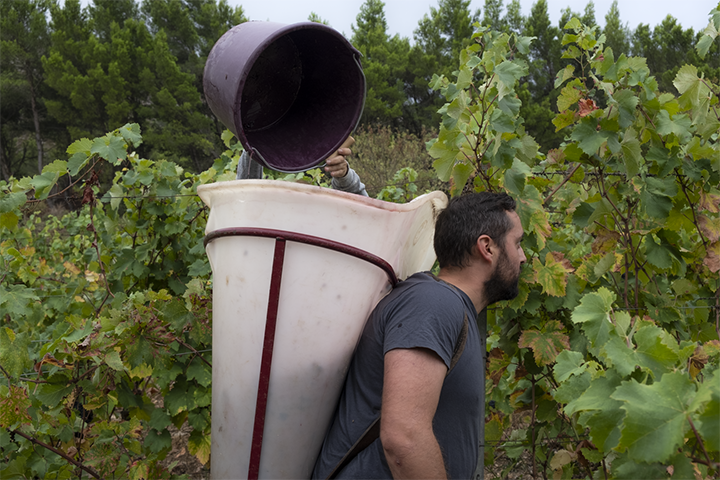
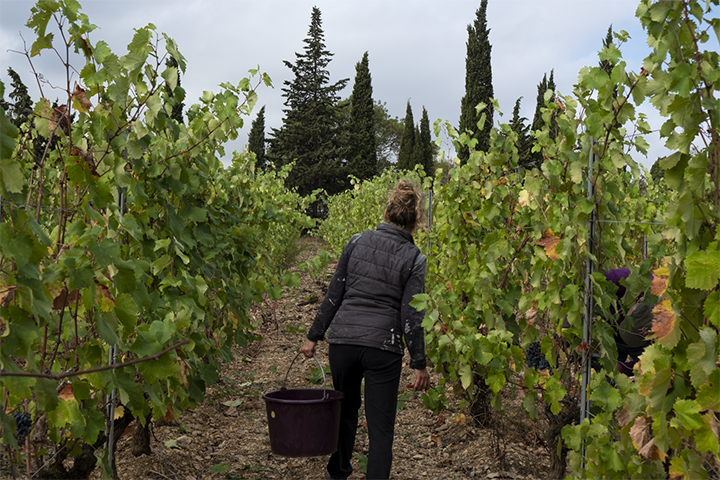
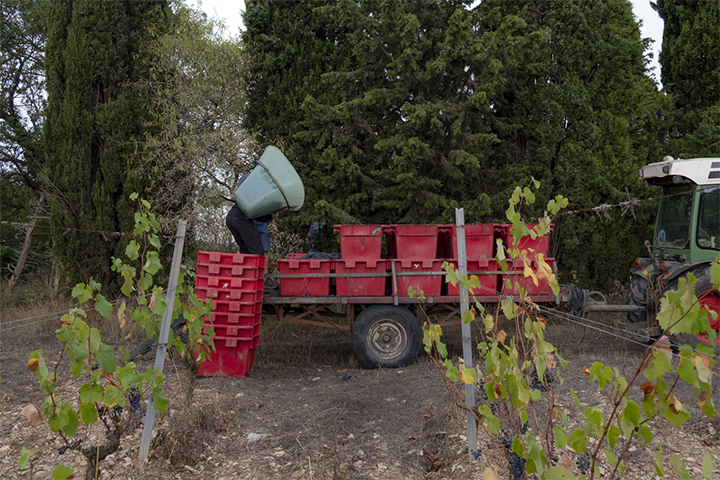
All photos Ⓒ Adèle Violette
More on wine and climate
Germany | Traditional Wine-Making Feeling The Heat of Climate Change



